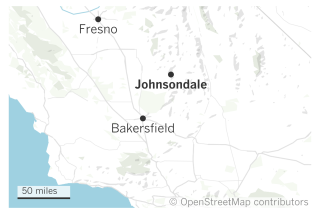Girl Near Death After She, Sister Fall in Pool : Tragedy: Grandmother pulled 3-year-old from the water. Minutes later, a firefighter found 5-year-old in the deep end.
- Share via
FULLERTON — A 5-year-old girl hovered near death Wednesday after she and her 3-year-old sister almost drowned while playing in their grandparents’ swimming pool, authorities reported.
Firefighters responding to an emergency call at 1831 N. Sunset Lane said they arrived to find 3-year-old Robyn Newkirk in the arms of her grandmother, who had seen her floating face down in the pool and pulled her to safety.
Then they spotted Randi, 5, wearing a pink bathing suit with black polka dots, at the bottom of the pool.
“I think we all saw at the same time a little girl laying face down in the deep end,” said firefighter Kevin Harleyman, 35. “I walked right in and down to the bottom. It took me about three, four or five seconds to bring her up. I kept thinking about my 3-year-old, Denver.”
Both girls were rushed to the emergency room of nearby St. Jude Hospital and Rehabilitation Center after being revived at the scene about 1 p.m. Robyn was listed in fair condition at St. Jude on Wednesday night. Randi was transferred to Childrens Hospital of Orange County and was breathing with the help of a respirator Wednesday evening.
Dr. Ralph W. Rucker, director of pulmonary services at Childrens Hospital, described the 5-year-old as being in “bad shape” and other doctors rated her chances of survival as slim. She was not breathing when she was pulled from the pool and her heart had stopped, authorities said.
The girls’ parents, David and Patricia Newkirk of Walnut, were not at the Fullerton home when the accident occurred but rushed to the hospital when they heard what happened to their daughters.
With the weather warming, Wednesday’s near-drowning of the two children served as a grim reminder of the dangers of back-yard swimming pools. Orange County has one of the highest numbers of pools per capita in the nation, said Ron Johnson, executive director of the Orange County Trauma Society--”and the drownings go hand in hand.”
“Summertime is here, and this is certainly a much more common occurrence,” said Dennis L. Ross, an emergency room physician at St. Jude. “Children just need to be watched. Nothing short of adult supervision is adequate.”
Rucker said 20% of drownings occur not in the parents’ pool, but rather “in grandmother’s pool. She’s baby-sitting and grandma is slow and the child is fast and the house is not baby-proofed.”
Statistics from the Orange County Health Care Agency show that an average of 17 children under the age of 9 have drowned every year since 1978. Nine have drowned so far this year. The figures don’t include near-drownings that have left some children severely injured or even brain-dead after falling into a pool.
Nationally, deaths from motor vehicle accidents are the leading cause of children’s deaths. But for many years in Orange County, “drowning deaths have been the leading cause of injury deaths in children,” said Dr. Hildy Meyers, an epidemiologist with the County Health Care Agency.
Wednesday’s tragedy happened as the girls’ grandmother, Lois Newkirk, 59, baby-sat them at her home in north Fullerton. After seeing Robyn floating face down, Newkirk pulled her from the pool, then called authorities for help and to report that she could not find Randi.
Fire Capt. Ray Sadler said that when his men arrived, Newkirk was running through the house with Robyn in her arms saying, “She’s not breathing.” As they went to her aid, other firefighters found Randi in the pool.
Authorities estimate that the little brunette was underwater for 10 to 15 minutes, although she was wearing a flotation device. It is not known how long her sister was in the water.
“The body of that child in the bottom of the pool is imprinted in my mind--in all our minds,” said firefighter Chuck Czuleger. “We are trained to rescue victims from swimming pools and we’re instructed to look for victims like that, but you never know it’s going to be something like that.”
Firefighters said they might not have looked in the swimming pool had not their dispatcher told them at the scene that Newkirk had reported one of the girls missing.
The girls’ grandmother and their parents, who were keeping a vigil at St. Jude and Childrens hospitals, were too stunned to talk about the incident.
“They’re just basically a really great family involved in the community and the church,” said Brent Fletcher, pastor of First Baptist Church of Walnut Valley. Fletcher and his wife, Jayne, went to St. Jude on Wednesday to console the Newkirks.
“They’d do anything for their girls and what’s best for their family,” Jayne Fletcher said. “Randi is kind of meek and shy. They’re two little girls we’d love to adopt.”
Neighbors said that Lois Newkirk and her husband, Russell, who have four children, often care for their 11 grandchildren and have them over to visit regularly. They added that it was not uncommon for the Newkirks’ relatives to use the pool, especially during the summer.
“She’s the kind of grandmother that does everything, the kind of grandmother people want,” said neighbor Karen Murchison, 35, who went to the hospital to help support the family.
The Newkirks’ pool is accessible through a gate in the back yard and a sliding glass door off the family room. The pool is about two feet deep in the shallow end and eight feet in the deep end. On the patio Wednesday were two inflatable life preservers in the shapes of a duck and a hippopotamus.
Randi remained in intensive care Wednesday night at Childrens Hospital. Doctors said she was in a coma and was assisted by a respirator, but sporadically breathed on her own.
“This is a personal tragedy,” said Dr. Gary Goodman, the girl’s physician. “If you’ve never had this happen, you cannot imagine how devastating it is--the sense of guilt, the sense of responsibility that’s left with them and the loss of this child that can never be replaced. There’s nothing, there’s no consolation that can make you at peace.”
Goodman said they will know Randi’s chances for recovery within 24 hours. But physicians fear that if she survives she will have brain damage, which begins about six minutes after a person has been without oxygen.
Although details about the incident were sketchy and the investigation is still under way, police and firefighters said there was no indication of foul play. “I have no reason to think that this was anything but a back-yard accident,” Fullerton Battalion Chief Jack Cooper said.
Drowning experts and public safety officials warn that a child left alone for only a moment can drown.
“It only takes a second,” the county’s Dr. Meyers said. “You turn your back. Kids that age can surprise you. Yesterday they might not have been able to open the door (to the yard) but today they can.”
Added Johnson of the Trauma Society: “Parents of drowning victims or near-drowners are not your neglectful parents. They’re your everyday people, very good parents. Usually it’s more of a lapse in attention than a lack of attention. It happens so quick.”
If parental inattention is part of the problem, the nature of young children is the other element in the equation.
“A child 2 years old is the stupidest person on the face of the Earth,” said Rucker of CHOC, who has spent years treating “the drowners”--toddlers who have fallen into their parents’ back-yard pools and been hauled out comatose.
“They lack experience, they lack knowledge. They can learn. It takes them a little longer. But they still have the speed, curiosity and strength that a 3-year-old or 4-year-old have,” he said.
Though Rucker and his colleagues at the Trauma Society have valiantly tried to teach parents that drownings are preventable, he is frustrated that over the years the numbers of Orange County drownings haven’t really changed. Year after year, Rucker said, CHOC cares for 35 to 45 near-drowning victims; 25% of these live with permanent brain damage or linger in a coma and die, he said.
To Rucker, drowning is “a preventable childhood disease. I don’t like to call it an accident because accident may mean something that you couldn’t control, something just happens. . . . But this is a social and communitywide disease. If we didn’t have pools in Orange County, we would eliminate 90% of the drownings.”
For all his concern about pools, Rucker is not an advocate of filling all of them in--though on one occasion last year he sanctioned just that. Last year, a Mission Viejo couple with three small children--the oldest age 4--filled in their pool with rocks because there was not enough room between the pool and the house to fence it properly.
Rucker, working with the Trauma Society, has also helped develop a prevention program--a puppet show on water safety that has been making the rounds of children’s groups for the last nine years.
This year, however, the puppet show is on hold while the Trauma Society develops a 30-minute video on safety that will be taken to new-mother “maternity teas” and parent groups. “Right now we’re trying to concentrate more on the adults,” Johnson said. “The key factor in prevention of drowning is adult supervision.”
Times staff writer Davan Maharaj and correspondents Danica Kirka and Tom McQueeny contributed to this story.
WAYS TO REDUCE POOL RISKS FOR CHILDREN
Orange County drowning-prevention experts offered several suggestions to deal with the potentially lethal combination of a young child and a swimming pool. “No one thing is the answer,” advises Ron Johnson, executive director of the Orange County Trauma Society. “But a combination” of these measures could prevent a tragedy.
Don’t allow a child near a pool unless he or she is watched constantly.
* Enclose the pool with five-foot fence and self-latching gate.
* Use a pool cover--preferably one you can see through in case a child somehow crawls under it.
* Put a child-proof latch on the back door.
* Install a telephone beside the pool. “This could save a life,” says Johnson. It would enable a quick call to the 911 emergency number after an accident but mostly prevents trouble by keeping a parent near the pool when the phone rings.
* Learn CPR and ask that baby-sitters learn it too. Said Dr. Ralph W. Rucker, Childrens Hospital of Orange County: “The difference (between a child who is brain-damaged and one who is not) is oftentimes what is given to the child at poolside.”
* Don’t count on children’s swimming classes--even ones that promise “drown-proofing”--to save your child if he or she falls in.
* Don’t leave toys floating in the pool. They attract children to pools, Johnson said.
ORANGE COUNTY DROWNING DEATHS
Children aged 9 and under: 1978: 14 deaths. 1989*: 9 deaths. * Estimate.
Source: Orange County Health Care Agency.
More to Read
Sign up for Essential California
The most important California stories and recommendations in your inbox every morning.
You may occasionally receive promotional content from the Los Angeles Times.














